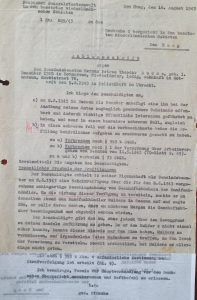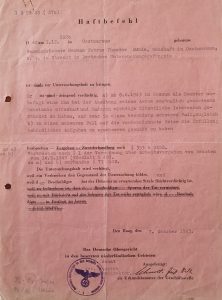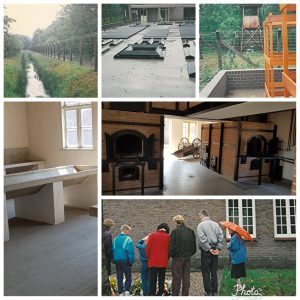Arrested and taken to Oldenzaal


Unfortunately, a “Nazi collaborator” found out what Herman had done and betrayed him and on June 9, 1943, he was arrested and taken to Oldenzaal for questioning. The next day he was taken to Enschede for further questioning
and imprisoned in Almelo the same day, where he was kept for two weeks.
The “offence” was considered by the Germans as a serious form of sabotage. Later, however, it turned out that there was much more behind it, because it was suspected that a resistance movement was active in and around Ootmarsum.
On 11 June, the Mayor of Ootmarsum wrote a letter to the Secretary-General of the Department of the Interior in The Hague entitled: ” In custody“. In it he indicates that he does not know why Herman was arrested, and that Herman worked as the ‘Cashier at the Distribution Office of the Council and that because of this arrest the already overloaded office is now faced with great operational difficulties “. Because of scarcity or because of German control, lots of products could only be obtained through stamps and based on a range of conditions these stamps were issued by the Distribution Office.
The mayor is asking for immediate exemption. But unfortunately, this quick reaction was to no avail.
I was able to locate a copy of the above letter as well as a copy of a letter from Der Genaralkommissar fur Verwalting und Justitz of the Ministry of the Interior (Generalsekretar im Ministerum des Innern) at the Netherlands Institute for War Documentation. In this last letter of 15 July, the initial imprisonment is confirmed as well as the above-mentioned reason. It also states that a speedy release is not likely.
Konzentrationslager Herzogenbusch (Camp Vught)

On 26 June 1943 he was transferred to the concentration camp in Vught; he was not even given the time to say goodbye to family and friends.
In the Netherlands Institute for War Documentation, the archives of Camp Vught have the original registration card of Herman as well as an updated form under his name of of the Red Cross. This contains his personal data; his prison number (2392) and his cell block (19) and that he entered the camp on 26 June 1943 and that he was transferred on 9 September of that year.
In the camp Herman, like many other civil servants residing there, was given an administrative position in the Schreibstube. According to Kerremans, the staff here had it reasonably easy and did have access to good nutrition. (J.M.Kerremans is the author of the book: Mijn Zwerftochten door Nederlands, Belgische en Duitse Concentratiekampen, where he was imprisoned from March 1942 to September 1944.)
The “gründliche” Germans expected the same accuracy from the Dutch prisoners as from their German personnel, but it was precisely this attitude that also enabled Herman and his colleagues to apply certain “creative administration”, so that extra rations could often be given to campmates.
Also, according to ‘Kerremans’, these people often passed on notes that they could remove before the Germans found them. These notes were sometimes in the food packages that the prisoners were allowed to receive from their families, but notes were forbidden.
Herman has never been able to talk much about his time, but this story always came back.
Butter smuggling
| One summer day Herman had managed to smuggle butter out of the storehouse. But on his way to his barrack he was apprehended and interrogated by a camp commander. It had nothing to do with the butter smuggling but in the meantime, he felt melted butter running down his legs.
However, the commander did not notice anything. Once he arrived in the barracks, he was put in cold water by his fellow prisoners so that the butter solidified so nothing would be lost. In a painful way, the butter was then plucked from his hairy legs. |
I am not sure if he was employed to do the following work, but he did tell me the following story.
Prisoners were also put to work on the construction of the camp which on his arrival was still not finished. They had only started earlier in 1942 and was not finished until early 1943. A (dry) moat around the concentration camp was one of the constructions that were underway. In a separate part of the camp, Jews were detained, who were treated much worse and had to work on the moat. Many of the malnourished prisoners had difficulty pushing fully loaded wheelbarrows up the steep slope of the moat. The German soldiers enjoyed kicking the wheelbarrow if they thought the prisoners were not working fast enough, so that they had to start all over again from the bottom of the moat.
Kerremans writes about this: “It was a kind of pioneering work, the site needed to be prepared for the camp to be build. The superintendents S.S. (military branch of the Nazi Party) and the kapos (supervisors of the prisoners, themselves also being prisoners) let you work until you collapsed. All day the bat was waving over your head. To indulge their sadistic tendencies, they had brought a dog, many of our boys have died from the injuries of dog bites”.
Herman, also said that the kapos were often worse than the S.S.
Kerreman writes that in Vught these kapos were convicted Germans, who under the command of the S.S. supervised the prisoners in the barracks and at work. It was they who hit the prisoners the hardest, they further spied on their fellow prisoners and wrote out reports, as a thank you these kapos often got alcohol. The prisoners that appeared in the reports received 25 canings or bunkering sentences on water and bread.
Herman’s sister Anny later told us that Herman’s mother suffered greatly from this situation, she became visibly grayer. Every morning she went to church to pray at the statue Mary of Everlasting Assistance.
The horrors of a concentration camp
| “If a roll call took place, you immediately had to drop everything you were doing and quickly run to the parade. A roll call could take hours because the Germans loved ‘gründlichkeit’.
During one of these incidents, a few Jewish prisoners ran to the roll call site. They were apprehended by some German soldiers who asked if they could not run a little faster. They were sent back and had to run again. They were stopped again asking if it couldn’t be done faster, and why did they walk around the lawn and not over it, that would be faster. They were sent back, and this time ran across the lawn and were immediately shot, because it was forbidden to walk on the grass.”  Following a visit to Camp Vught in October 2003, I received the following information: “The Vught National Monument Foundation has copies of the deeds of death, insofar as they were recovered after the war. We started searching in the period that your father was in Vught. One of the deeds states as the cause of death: “Auf der Flucht erschossen” (Louis Israel, 5 September 1943). This could indicate the story your father talked about. The prisoners were forced to walk over forbidden territory and then they were “punished”. More stories are known about these atrocities. It is the horrors that lie behind the term “shot to death on the run”. In 1988, the camp was declared an official Dutch war memorial. |
Kerremans also describes the roll call. This took place three times a day at 6.30, 12.00 and in the evening when everyone was back from work there was the main roll call. They were done by the number of the barracks and by prison number. If prisoners went missing, the S.S. started searching with the dogs and everyone, stiff in the posture, had to keep waiting. Kerremans writes that once it had happened that they waited twice for 24 hours without food or drink, usually the evening roll call took an ‘hour’.
The most feared Nazi organisation was the SS
| The Schutzstaffel (SS) (Protection Squadron) also stylised with the ᛋᛋ runes grew into one of the most powerful organisations in Nazi Germany. They were the foremost agency of security, surveillance, and terror within Germany and German-occupied Europe. The two main constituent groups were the Allgemeine SS (General SS) and Waffen-SS (Armed SS).
The Allgemeine SS was responsible for enforcing the racial policy of Nazi Germany and general policing, whereas the Waffen-SS consisted of combat units. A third component of the SS, the SS-Totenkopfverbände (SS-TV; “Death’s Head Units”), ran the concentration camps and extermination camps. Additional subdivisions of the SS included the Gestapo and the Sicherheitsdienst (SD). They were tasked with the detection of actual or potential enemies of the Nazi state, the neutralisation of any opposition, policing the German people for their commitment to Nazi ideology, and providing domestic and foreign intelligence. The SS was the organisation most responsible for the genocidal killing of an estimated 6 million Jews and millions of other victims during the Holocaust. Members of all its branches committed war crimes and crimes against humanity during World War II. The SS was also involved in commercial enterprises and exploited concentration camp inmates as slave labour. |
On 23 August, the mayor of Ootmarsum wrote another letter to the Ministry of the Interior. Once again, he strongly advocates the release of Herman, repeats the same reasons and adds to this in relation to the offence ‘ In this case he has certainly acted incorrectly, but I am convinced that the punishment he is now undergoing is more than sufficient, to prevent him from making such mistakes. He also advocates indemnifying Herman against dismissal from his position.
On 31 August, the Ministry of the Interior wrote in a letter to Der Genaralkommissar fur Verwalting und Justitz that the Ministry agrees with the mayor and blames the criminal offence made by Budde on ‘ unthinkingness, which is related to his youth‘. The Ministry also advocates a speedy release and further mentions as a mitigating measure, which was also cited by the mayor “the correct and benevolent attitude with which Budde has always treated the German soldiers“.
Herman never held a grudge against individual Germans, but he truly hated and despised the Nazi system.